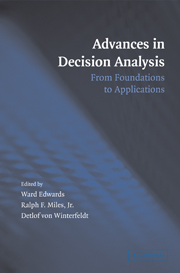Book contents
- Frontmatter
- Contents
- List of Contributors
- Preface
- 1 Introduction
- PART I HISTORY AND FOUNDATIONS OF DECISION ANALYSIS
- PART II STRUCTURING DECISION PROBLEMS
- PART III PROBABILITIES AND BAYES NETS
- PART IV UTILITIES
- PART V RISK ANALYSIS
- PART VI DECISION ANALYSIS IN A BEHAVIORAL AND ORGANIZATIONAL CONTEXT
- 18 What Have We Learned from Our Mistakes?
- 19 Decision Conferencing
- 20 Resource Allocation Decisions
- 21 From Decision Analysis to the Decision Organization
- 22 Building Decision Competency in Organizations
- 23 Negotiation Analysis: Between Decisions and Games
- PART VII APPLICATIONS OF DECISION ANALYSIS
- Index
- References
20 - Resource Allocation Decisions
Published online by Cambridge University Press: 05 June 2012
- Frontmatter
- Contents
- List of Contributors
- Preface
- 1 Introduction
- PART I HISTORY AND FOUNDATIONS OF DECISION ANALYSIS
- PART II STRUCTURING DECISION PROBLEMS
- PART III PROBABILITIES AND BAYES NETS
- PART IV UTILITIES
- PART V RISK ANALYSIS
- PART VI DECISION ANALYSIS IN A BEHAVIORAL AND ORGANIZATIONAL CONTEXT
- 18 What Have We Learned from Our Mistakes?
- 19 Decision Conferencing
- 20 Resource Allocation Decisions
- 21 From Decision Analysis to the Decision Organization
- 22 Building Decision Competency in Organizations
- 23 Negotiation Analysis: Between Decisions and Games
- PART VII APPLICATIONS OF DECISION ANALYSIS
- Index
- References
Summary
ABSTRACT. Organizations typically have more good ideas for projects than they have resources available to pursue those ideas. Decision analysis can provide practical guidance to the organization on how to get the maximum benefit from those limited resources. This chapter reviews methods for prioritizing projects using mathematical optimization or benefit-cost ratios in concert with standard decision-analysis and risk-analysis tools. These tools include multiattribute utility and value models, decision trees, influence diagrams, and Monte Carlo simulation. To illustrate issues that arise in implementing these approaches in organizations, the use of resource allocation models in hospital capital budgeting is described at length. The chapter concludes with a call for more research on the use of decision analysis in organizational settings.
The challenge of Organizational Resource Allocation
What universal dilemma is confronted by organizations of every size, type, and purpose? Stated simply, they have more good ideas for projects, programs, and investments than they have resources available to pursue those ideas. These ideas include facilities expansion or construction, new equipment, innovative manufacturing or service delivery technologies, and information technology upgrades. In addition, many organizations engage in research and development efforts that require identifying the most promising new products, technologies, or process improvements.
Often, the limiting resource is financial because an organization's capacity to borrow funds or raise equity capital has practical limits. There also may be insufficient facility capacity, or not enough time to pursue every idea. In other instances, specialized skills or expertise are the limiting factor.
Information
- Type
- Chapter
- Information
- Advances in Decision AnalysisFrom Foundations to Applications, pp. 400 - 418Publisher: Cambridge University PressPrint publication year: 2007
References
Accessibility standard: Unknown
Why this information is here
This section outlines the accessibility features of this content - including support for screen readers, full keyboard navigation and high-contrast display options. This may not be relevant for you.Accessibility Information
- 44
- Cited by
